From the blog: The shifting landscape of Italian politics over the past few weeks is just the latest chapter in a longstanding narrative of political risk and uncertainty that appears to threaten both the eurozone’s economic recovery and the European Central Bank’s monetary policy framework perpetually.
From the outset, an Italian government formed of a coalition between the Five Star Movement and League political parties was always going to be the least market-friendly outcome from Italy’s March election.
History teaches us that European financial markets respond negatively to any perceived threat to the cohesiveness and evolution of the European project: the EU, European Economic Area or the euro currency itself.
While the very latest developments, at the time of writing, are looking to instil a modicum of calm, thoughts should now be turning to the likelihood of much needed additional reforms within the European financial infrastructure and the next steps regarding the ECB’s policy stance.
ECB is stronger than before
The ECB’s own toolbox (including the public sector purchase programme, outright monetary transactions, long-term refinancing operations etc.) has deepened significantly following the 2010-12 crisis.
This surely prevents a return to the extreme market reaction witnessed then and greatly reduces the potential for a genuine euro breakup scenario now.
But the mere fact of tighter monetary policy could cause problems for investors – as the ECB’s quantitative easing programme ends, that price-insensitive buyer of government bonds will need to be replaced.

Source: Bloomberg
This is before the raising of deposit rates, which will precede an eventual quantitative tightening scenario, the current modus operandi for the US Federal Reserve.
Given the potential for fiscal reforms to be significantly reduced and the expectation for the ECB’s monetary policy to tighten, European bond market investors should prepare for a bumpy road ahead.
Look past QE nations
On a relative basis, government bonds issued by nations with limited exposure to unwinding monetary stimulus, such as Australia or Canada, should be more attractive to investors.
Furthermore, the impact on the UK gilt market, and hence UK pension schemes’ liabilities, should also be at the forefront of investment considerations.
In this context the potential for gilts to take on “safe-haven status”, causing gilt yields to fall is similar today as it was in 2011/12, when yields fell to what were then record lows.
Tom Rivers is a senior investment strategist at Cardano






















